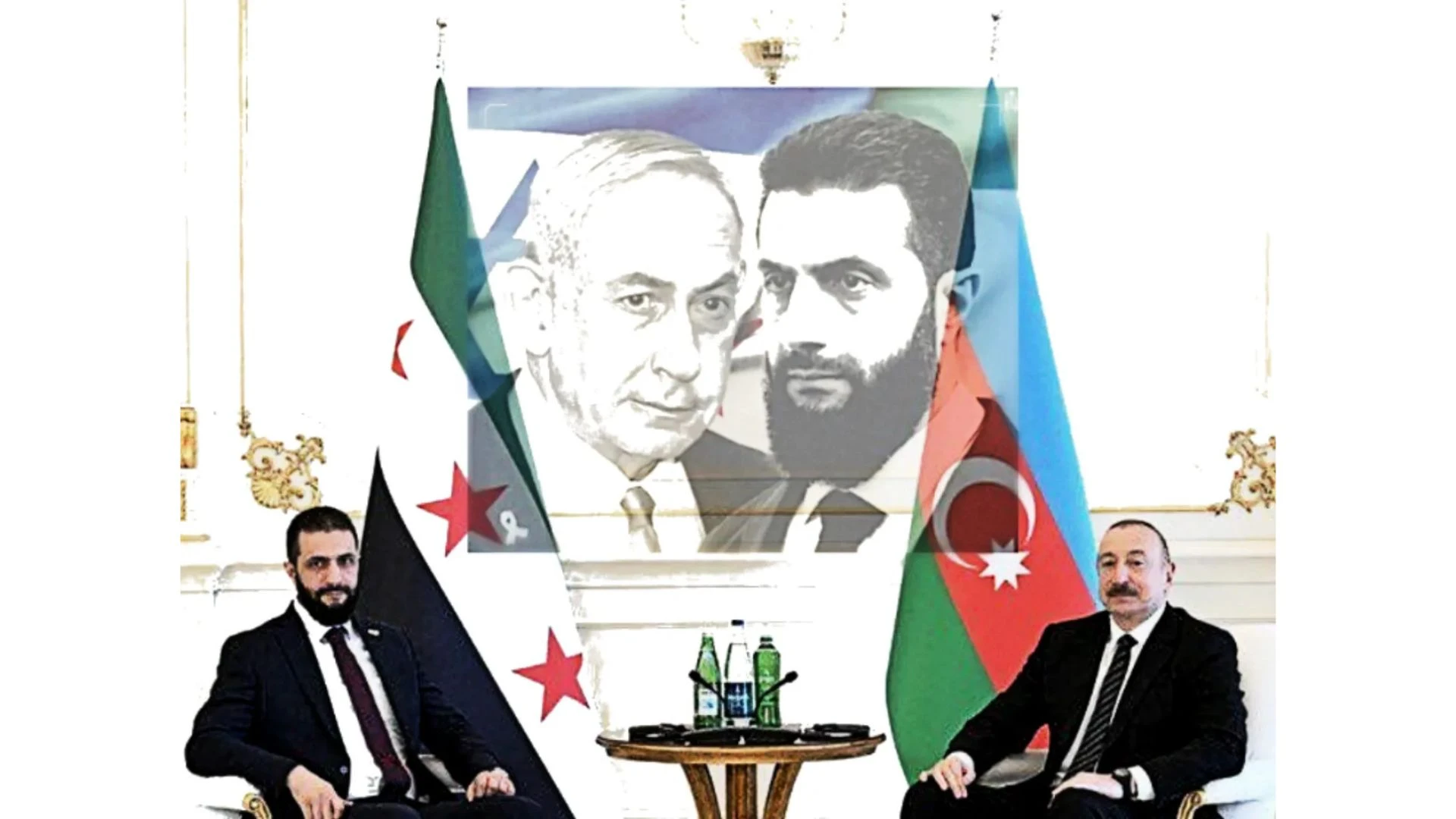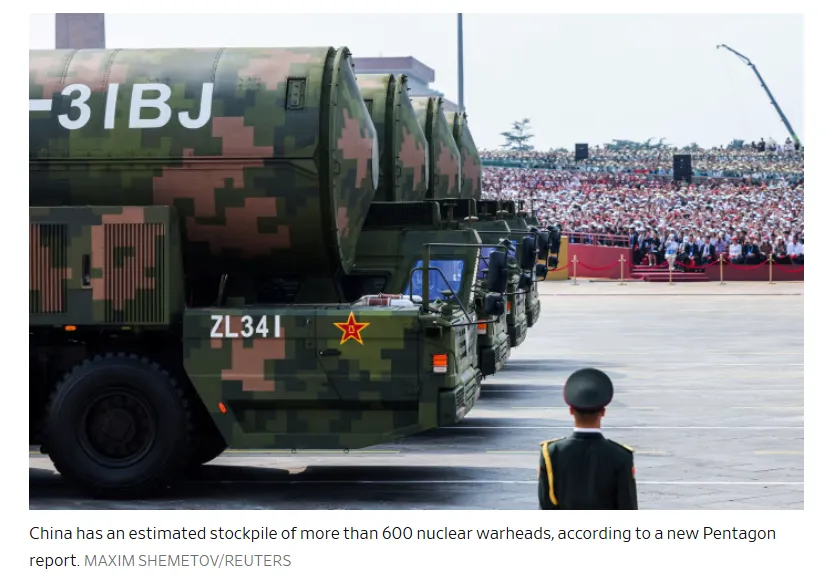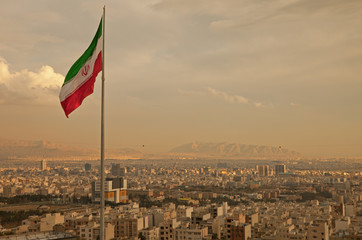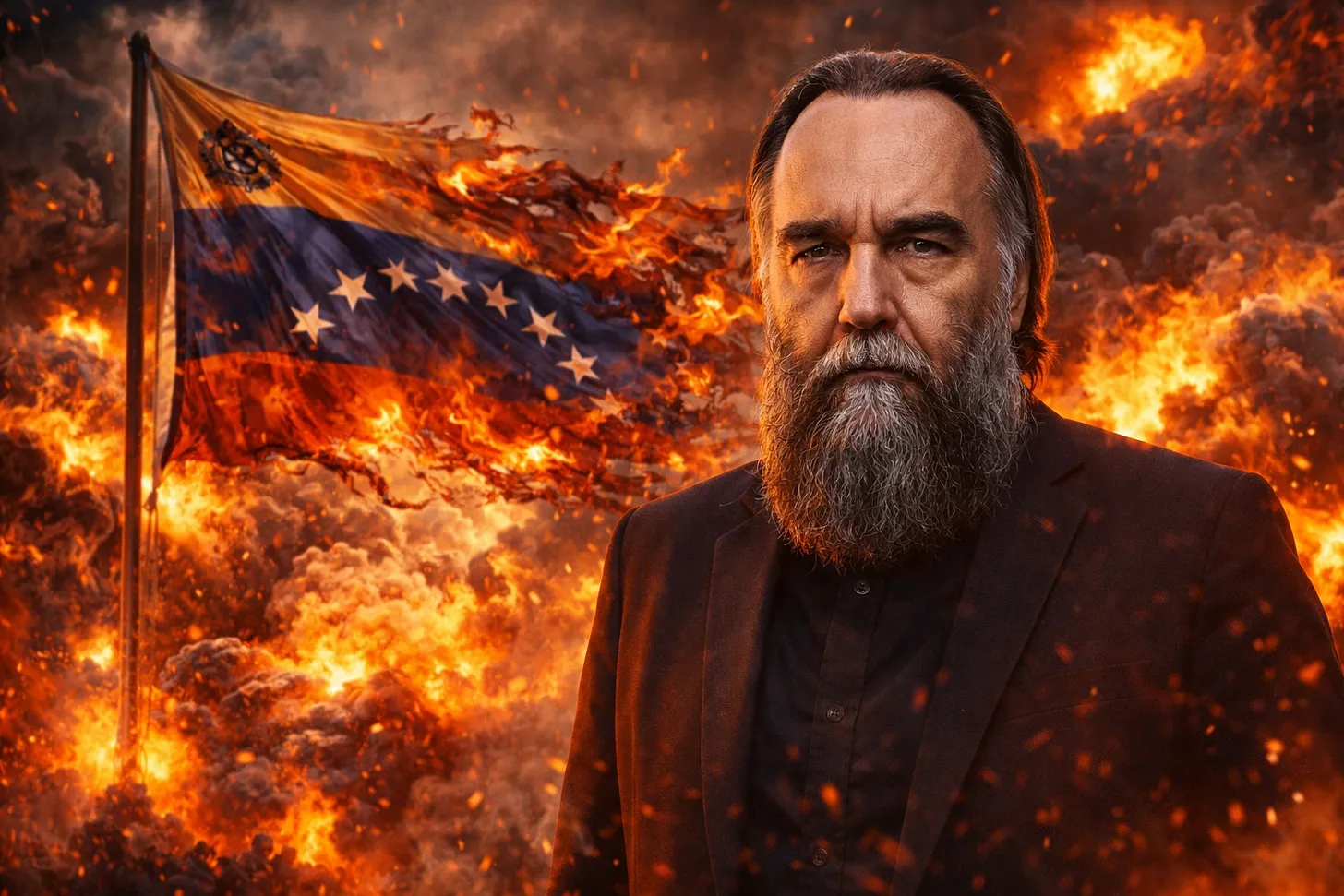Author’s Note: Events are moving very fast in the region and rumours are rife—the information in the article is accurate but updates will be required in the near future.
With the fall of Syria came the reshaping of the Resistance Axis, weakened by the loss of the central hub linking the regional state and non-state actors, and providing the land bridge that connected Iran to Palestine. Syria was historically instrumental in the manufacture and development of the weapons being used by the Palestinian and Lebanese Resistance factions against Israel.
This is an update on the current state of affairs in the region, focusing on Lebanon and Syria since the ‘ceasefire’ between the US, Israel, and Iran. It is a ceasefire designed to enable Israel to replenish air defence interceptor supplies and to prepare for the next stage of the long war against Iran. As with the ceasefire between Iran and Hezbollah that came into effect on 27 November 2024, we saw a US/Israel pivot to Syria and the fall of the Syrian Government within ten days, leading to an Al Qaeda Junta controlling Syria and acting as a de facto Zionist alliance proxy in the region.
Lebanon
Trump’s inexperienced, economic hit-man, and envoy to the Middle East (West Asia) is Thomas Barrack. In recent weeks, Barrack has been pushing the Lebanese Government for the full disarmament of Hezbollah, contrary to UN resolution 1701, which specifies the withdrawal of Hezbollah to the north of the Litani River. Both the US and Trump’s advisors know that this is an unrealistic demand, as Hezbollah will never agree to disarm while Israel is on their borders and occupying land in southern Lebanon.
Barrack is demanding that the disarmament comes into effect within four months, which is also unrealistic. In the 1980s, after the Lebanese Civil War, the Zionist-aligned Lebanese Forces were disarmed, which at the time represented less than 10% of Hezbollah’s capabilities. This process took two or three years.
Proposing the disarmament of Hezbollah is a similar tactic to demanding Iran abandons its nuclear energy development or its defensive missile program. The Zionist bloc know it will not be adopted. For Israel, the goal is to weaken the Resistance in Lebanon and Iraq in the interim period before a resurgence of aggression against Iran. The preferred option in Lebanon is to manufacture a civil war which will occupy Hezbollah internally, reducing their ability to react to Israeli aggression, in theory. However, this is a miscalculation on the part of the Zionist bloc.
Barrack is insistent upon the Hezbollah disarmament, but he is not applying the same pressure on Israel to withdraw from southern Lebanon, or to stop its daily bombing raids and drone assassinations across Lebanon.
Hezbollah has demonstrated its ability to withstand and prevent any serious ground invasion by the Zionist forces, while the Lebanese Army (LAF) has been unable to prevent further Zionist incursions since the ceasefire. This is largely because the US, the chief sponsor of the LAF, has ensured that the LAF are not equipped with air defence capabilities or the ground superiority necessary to be able to defend the country against the asymmetric force of the US-empowered Zionist military. They are restricted to ‘reporting’ the daily Zionist violations and regular assassinations of Lebanese civilians on the basis that they are ‘Hezbollah’.
A recent video has been circulating showing the Zionist drone assassination of a retired LAF officer, injured and exposed, while villagers are shouting at him to make it to the shelter of the trees. He responds that he is “too tired”. His neighbours were unable to reach him because they too would have been killed. This is how Israel operates across the region, from Gaza to Iran.

Tripoli in the North of Lebanon
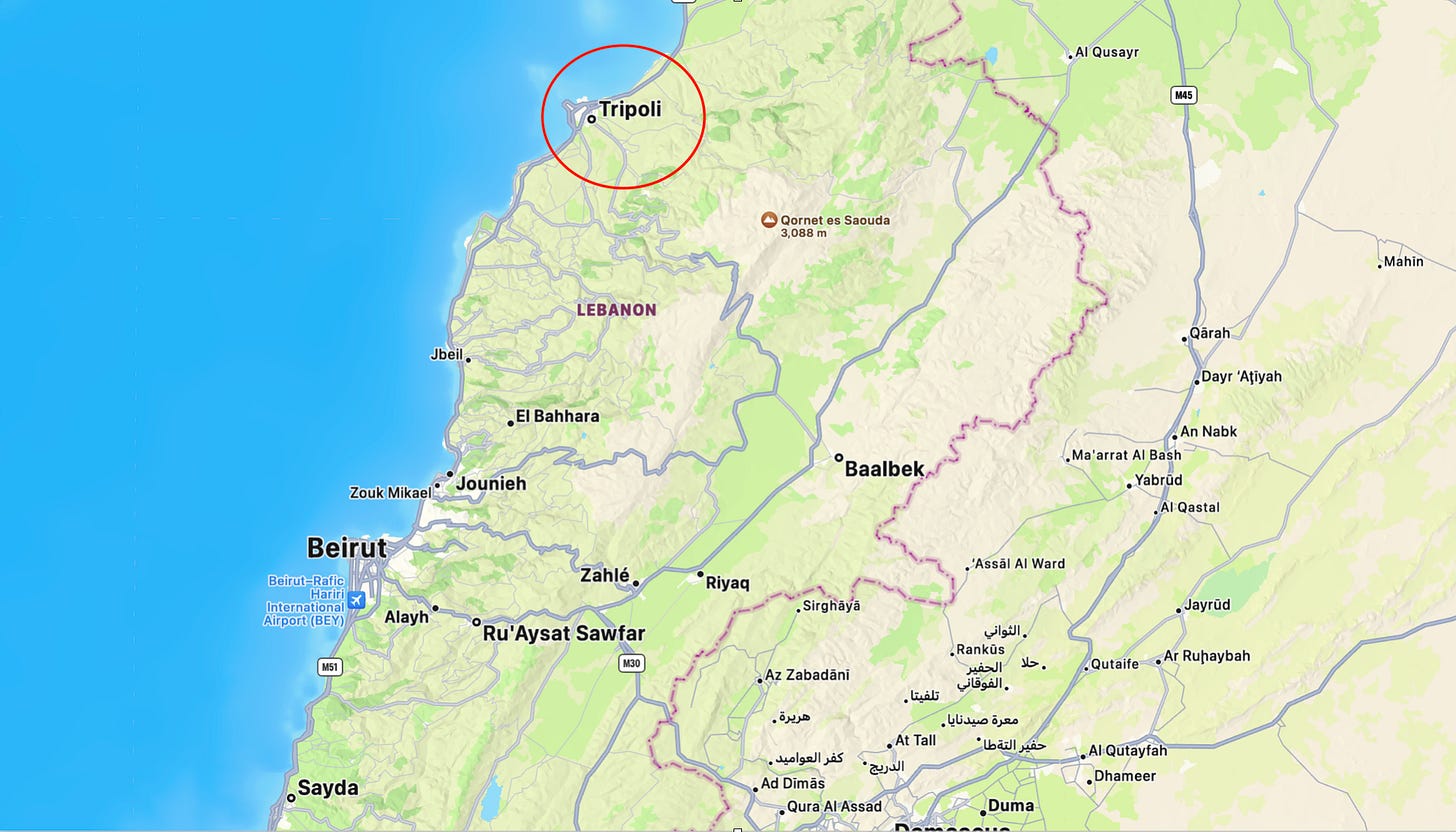
Israel has recently carried out strikes in Tripoli. This is a new development. It is significant when one takes into consideration the rhetoric from both Barrack and the Al Qaeda chief, Abu Mohammed Al Jolani (now known as Ahmed Al Sharaa), which will be discussed in this article.
The Zionists know that they are incapable of defeating Hezbollah in a ground war. The same applies across the region, including Gaza, where the Resistance have been inflicting huge damage to the Zionist forces in recent weeks. Any direct invasion of Lebanon will bring only crushing defeat, and it will damage the political cliff-hanging of Netanyahu, maintaining power through perpetual war dependent upon Blitzkreig tactics.
The alternative is to weaponise the new Syrian Takfiri regime against Lebanon to secure the Zionist agenda. Rumours have been rife in Israeli media of a deal that Jolani has allegedly concocted to bring Israel to the ‘negotiating table’ with Syria:
- Scenario 1: Israel would retain strategic areas in the Golan Heights equivalent to one-third of its territory, hand over a third to Syria, and lease another third from Syria for a period of 25 years.
- Scenario 2: Israel keeps two-thirds of the Golan Heights, and hands over the remaining third to Syria, with the possibility of its lease. Under this scenario, the Lebanese city of Tripoli, close to the Lebanese-Syrian border, and possibly other Lebanese territories in the north of the country and the Beqaa Valley, would be handed over to Syria [emphasis added].
The threats against Lebanon have been amplified by Barrack, who has said if Hezbollah is not disarmed, Syria will annex northern Lebanon as part of Greater Syria—Bilad Al Sham. It is a claim to Syrian ownership of Lebanese territory that is not evidenced by the history of Tripoli.
“You have Israel on one side, you have Iran on the other, and now you have Syria manifesting itself so quickly that if Lebanon doesn’t move, it’s going to be Bilad Al Sham again”. Barrack goes on to incite factions within Lebanon against the Resistance: “Syrians say Lebanon is our beach resort. So we need to move. And I know how frustrated the Lebanese people are. It frustrates me”.
Barrack later tried to walk his remarks back on X:
- My comments yesterday praised Syria’s impressive strides, not a threat to Lebanon. I observed the reality that Syria is moving at light speed to seize the historic opportunity presented by POTUS’ lifting of sanctions: Investment from Turkiye and the Gulf, diplomatic outreach to neighboring countries and a clear vision for the future. I can assure that Syria’s leaders only want coexistence and mutual prosperity with Lebanon, and the US is committed to supporting that relationship between two equal and sovereign neighbors enjoying peace and prosperity.
This statement was met with derision and condemnation from many X accounts.
Jolani has also allegedly threatened Lebanon over the thousands of Takfiri prisoners held in Lebanese prisons. Demanding their repatriation, which would swell the ranks of the HTS militia, Jolani threatened to close borders and to apply economic pressure on Lebanon if his demands were not fulfilled. While this has been denied by the ‘New Syria’ Minister of Information, many believe that the threats are real.
The threat from Syria also has potential for the entry of Takfiri factions from the north and east of Lebanon. There have been rumours of Jolani militia entering Tripoli by boat, denied by the LAF, but confirmed by some civilians in the area. Terrorist cells were recently captured in the Mount Lebanon area in the area above Beirut and in other areas of the country. These cells are described as having connections to ISIS.
Preparations have been ongoing for some time to repel attacks from HTS foreign Takfiri elements along Lebanon’s northeastern borders. These aggressors consist of Uighur, Uzbek, and Chechen terrorists who have been gathering on the border and reinforcing their positions. Lebanese tribal factions in the area have been gathering to defend their land alongside the LAF forces already present. Hezbollah is largely absent from these preparations for the time being.
A verified source in Syria told a Telegram channel that there is a security pact between Israel and ‘New Syria’. Should Lebanon refuse to join the Abraham Accords and ‘normalise’ relations with the Zionist entiry, Jolani will carry out attacks against Lebanon.
President Aoun of Lebanon has now ruled out the normalisation, and he is demanding full withdrawal of the Zionist forces from southern Lebanon.
According to the source, planning for the invasion scenario is already underway. Jolani is being groomed as a regional enforcer for Israel, a role that may extend into Iraq in the future. President Trump’s lavish praise of Jolani as a “strong fighter with a robust past” is linked to the role that the US will fully approve. The US has ostensibly lifted sanctions that were crippling the Syrian economy and recovery, while lifting the foreign terrorist designation from HTS, formerly Al Nusra Front or Al Qaeda in Syria. Any such concessions will come at a cost for Jolani and the Takfiri forces under his tenuous command.
The plans are to facilitate the entry of Takfiri elements into northern Lebanon, deploy foreign Takfiri forces along the eastern border with artillery and heavy weapons, trigger sleeper cells inside Lebanon to carry out suicide bombings, and perhaps to incite civil unrest among the enemies of Hezbollah. Simultaneously, Israel might expand deeper into the southern territory with the tacit approval of the US.
This is the plan, but will it work? Ten or twenty thousand Uighur, Uzbek, Chechen, and even Syrian extremists cannot defeat Hezbollah in a ground confrontation. The northern Lebanese tribes repelled heavy Takfiri attacks previously, with no help from the LAF or Hezbollah.
The situation could actually reverse at some point, with Hezbollah entering Syrian territory. Hezbollah would not be alone in such a battle. The LAF as well as the Akkar and Bekaa Valley tribes would mobilise to defend the borders. The battle would be an invasion of Lebanese territory by Syria, which is something that virtually all Lebanese would not accept. This would actually increase the popularity of Hezbollah as the most significant defence force in the country. Even the hardcore enemies of Hezbollah, who might reluctantly accept Israeli occupation, would never accept the invasion or annexation of Lebanese territory by Jolani/Syria or a Takfiri occupation.
The LAF would have to counter the Israeli invasion in the south which, again, would swing popular opinion against Israeli aggression and raise the issue of Lebanese sovereignty at a political level. This is something that the US alliance, the Arab Gulf States, and Israel want to avoid. A united Lebanon is not conducive to their expansionist project.
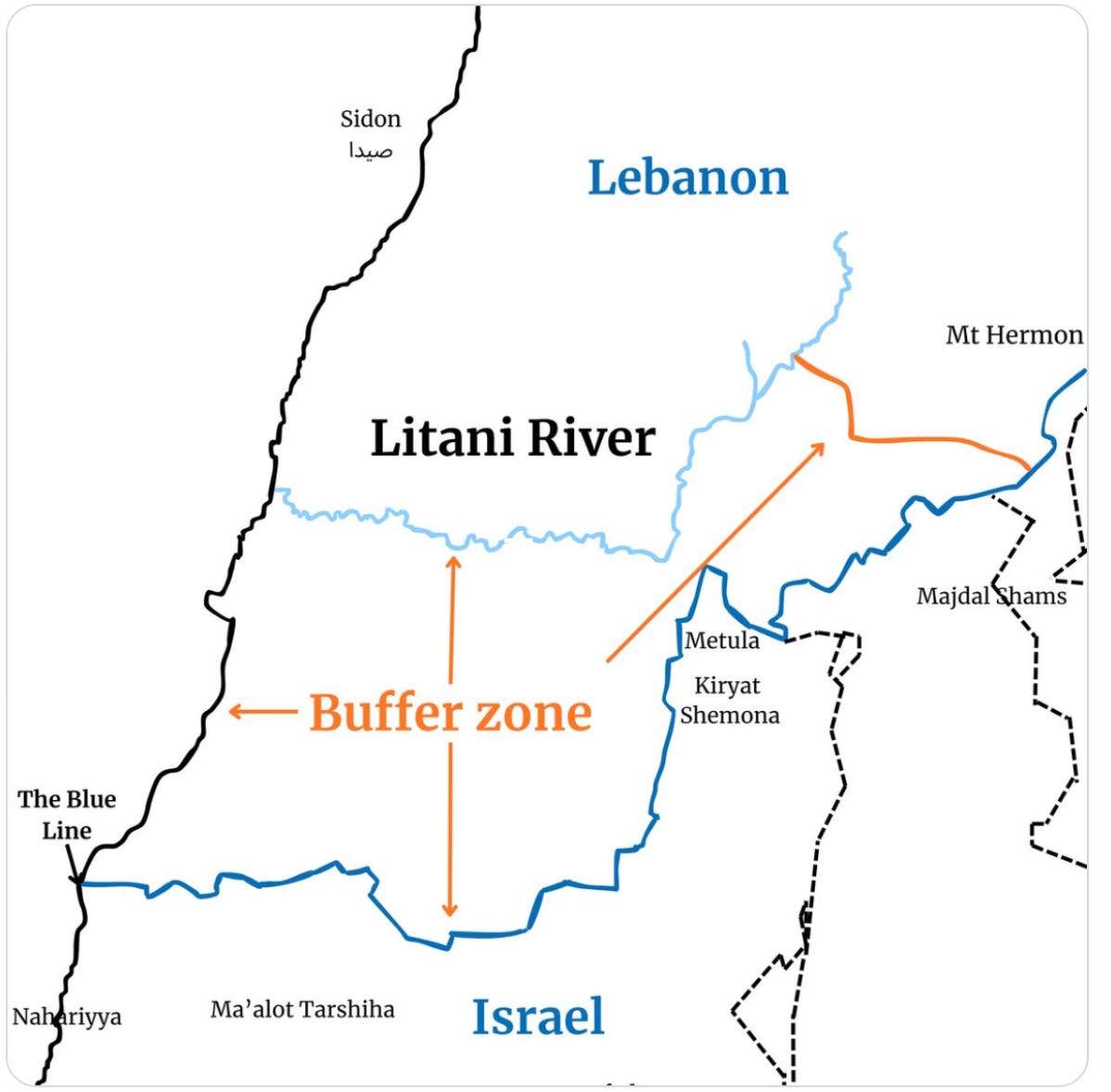
The Hezbollah withdrawal from the south of the Litani River does not negate their capability to redeploy or to conduct attacks against the Zionist forces from north of the river.
Effectively, the plan is a huge gamble for the Zionist bloc. It is fine to sacrifice Syrian Takfiri proxies connected to Al Qaeda and ISIS, but it could easily backfire.
Israel took control of Mt. Hermon in Syria on the border with Lebanon as a very important strategic military site. They intend to use the base to launch artillery attacks against the Resistance but primarily as a surveillance and espionage hub. However, it is a prime target for the Hezbollah drones and missiles.
Plan B would be for the bloc to continue to apply crippling economic pressure on Lebanon, to withhold reconstruction funding, and to reduce Hezbollah’s financial resources by curtailing the Hezbollah Qard Al-Hassan banking system. This system is not based on usury, but rather on interest-free cooperative loans that are available to all Lebanese. The US would impose sanctions and blame Hezbollah in an effort to turn Lebanese and the Lebanese state against the party.
Syria is Now the Crossroads for Regional Interests
Part of the alleged security deal between Jolani and Israel includes a Syria, Turkey, and Israel deal to bring water from the Euphrates through Syria to Israel. The problem with this project lies in the competing spheres of influence. Turkey is a NATO member state, and a long-time intelligence, arms, and economic ally of Israel. Baku oil is being supplied to Israel through Turkey, despite the ongoing Zionist genocide in Gaza and expansion of land grab in the West Bank.
Syria is a major area of competition for Israel and Turkey. The Greater Israel project clashes with the neo-Ottoman empire. President Erdogan’s aspirations are to have sole guardianship of Syria post-Assad. Jolani has changed the rules of the game, as he did when he left ISIS to establish Al Qaeda in Syria.
After the fall of Damascus, we saw Saudi Arabia take centre stage, brokering the meeting between Jolani and Trump, with Erdogan participating via telephone link. This was one of the first signs of a weakening in the Turkish influence over Jolani, at least from a political perspective.
The US views regional interests through the lens of Israel. Erdogan does not want Syria to normalise with Israel, even though he would not say so publicly. Jolani is clearly edging towards a first phase of normalisation, which is a condition set by Trump for the lifting of sanctions and potentially other ‘under the table’ deals. For Erdogan, normalisation means the Zionisation of Syria and the reduction of his role in the country. It would also mean increased Gulf State influence, which would be a blow to Erdogan, positioning himself as the leader of the Muslim world.
For Saudi Arabia, Syria would be a doorway to Europe, and Jolani would give the Arab Gulf States exclusive access to Syrian resources, marginalising or excluding Turkey and even perhaps Russia, which has historically had the exploration rights to Syrian coastal gas reserves. If Syria takes steps towards normalisation with Israel, Saudi Arabia can more easily go down the same route with less popular backlash.
Saudi Arabia has good relations with the US/Israel-backed Kurdish SDF factions in the north, while Turkey’s historical enmity with the Kurds is hindering the centralisation deal between Jolani and the SDF. The Gulf Cooperation Council (GCC) led by Saudi Arabia can provide the investment needed for Syria’s economic recovery more easily than Turkey, whose economy has been decimated by Erdogan’s involvement in funding the regime change war against Syria since 2011. Added to all this, Turkish media has recently reported on plots to assassinate Jolani, allegedly foiled by Turkish Intelligence. This story has been denied by the Jolani administration. It is a scenario that serves only to push Jolani closer to Israel. Finally, the Syrian National Army, which is fully backed by Turkey, could present a serious challenge to Jolani’s leadership. Cooperation with Israel might give Jolani some protection from a possible SNA coup.
Local sources in Damascus report that Mossad operatives are regular visitors to the Four Seasons Hotel, along with American, British, and French Intelligence agents. Previously, Turkish intelligence dominated the post-Assad scene in Damascus. However, squeezing Erdogan out of the Syrian picture beyond containment in the north could lead to unintended consequences for Jolani and the Zionist bloc.
The Water War
The Syrian population is suffering from a severe shortage of drinking water due to a scarcity of rain in the last few winters. Water rationing in Damascus has reached unprecedented levels, and it is expected to get worse in the peak summer months. It is no coincidence that Israel, which takes 30% of its water needs from the occupied Syrian Golan, wants to take control of the groundwater-rich Yarmouk Basin, Mt. Hermon (a natural water reservoir for melting snow and rainwater), and other areas rich in water resources like the Al Mantara Dam near Daraa in southern Syria.
The David’s Corridor, which will connect Israel to eastern Syria, not only guarantees Israeli military occupation, but provides access to the Euphrates River, which is controlled by Turkey through a system of dams. Turkey has deliberately reduced water levels as a pressure mechanism and siege against the Kurdish factions in the northeast. Israel, on the other hand, sees the Kurds as a convenient ally to facilitate Israel’s access to the water supply. The complexities surrounding the alliances in Syria have now become untenable for many of the regional players.
Will the US Supply Weapons to Jolani, and Are the Sanctions Really over?
With the apparent lifting of the terrorist designation for HTS, there is a risk that the US will take advantage of the legitimisation of the HTS regime to supply weapons to help Jolani reinforce Israel’s security in the region.
It must be noted that the US will never allow Syria to possess heavy weapons, air defence, or a viable navy or air force, similar to the LAF. This is to reduce the potential threat to Israel now or in the future. Perhaps they have learned from the Timber Sycamore weapons for ‘moderate rebels’ falling into the hands of ISIS? That is unlikely, because the US engineered the support for ISIS while disguising it as support for the moderates.
However, it is true that the weapons could be used in the future by opposition Takfiri factions or even Resistance movements opposed to Israel. This is also why Israel regularly targets weapons storage sites whenever it learns of their presence in Syria. It is also why Israel has bombed any attempt by Turkey to establish HTS air defence facilities or a Turkish military presence in central Syria.
The only weapons that will be available to HTS are light and medium weapons, sufficient to engage Hezbollah and the LAF, or even the Iraqi Resistance in the future. This ensures a confrontation that would be long and exhausting without the guarantee of a victory for either side. It would be perfectly organised chaos that serves the agenda of the US and Israel by ensuring that Hezbollah is preoccupied with Syria, should the aggression against Iran reignite.
According to a reliable source in Syria, there are misconceptions over the lifting of sanctions on Syria. The following points were made:
- Trump lifted sanctions on 519 individuals and entities. It was a PR stunt. Some sanctions were lifted from former President Bashar Al Assad and some former government officials.
- The most important and damaging sanctions related to economic support and reconstruction, such as the Caesar Act and designating Syria as a ‘state sponsor of terrorism’, were not removed.
- These laws require a congressional resolution, and Trump alone does not have the authority to repeal them. Trump could have granted a temporary waiver for six months or a year pending congressional approval, but he did not do this.
- The decision issued by US Secretary of State Marco Rubio to rescind the designation of ‘Jabhat al-Nusra/Hay’at Tahrir al-Sham’ as a Foreign Terrorist Organization (FTO) under 8 U.S.C. 1189(a)(6)(A) does not, in any way, remove the entity from the sanctions lists under 50 U.S.C. 1702. So, this is also a PR exercise that largely benefits the US and Israel, not Jolani, as the sanctions threat is still in place.
- Effectively, HTS is no longer a ‘Foreign Terrorist Organisation’, but it is still a ‘Specially Designated Global Terrorist’. This means members of HTS can visit New York and Paris, but nobody can have financial dealings with them or send them weapons directly, at least not before the Treasury Department issues a decision to lift this status.
All of the above is confirmed by the phone call between Asaad Al Shaibani, the Al Qaeda Foreign Minister, and Marco Rubio. Shaibani did not thank Rubio for the decision, but he expressed hope for further relief from terrorist labels and the Caesar Sanctions. The aforementioned decisions were taken to enable Jolani’s presence at the UN General Assembly meeting in September, which is being heralded as an opportunity for Netanyahu and Jolani to meet and to finalise the ‘security’ agreement.
The Importance of Homs, Syria, on the Border with Lebanon
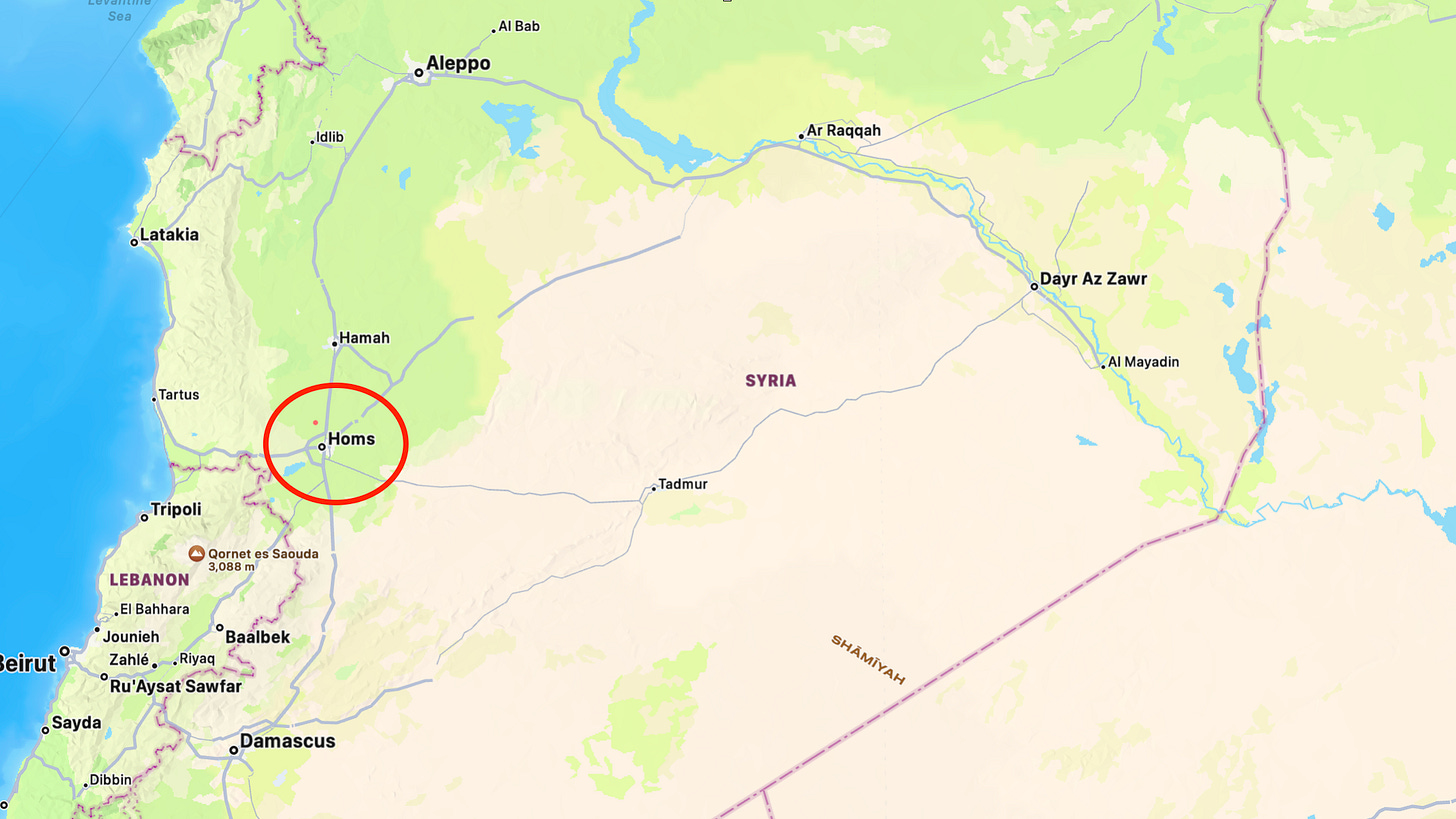
Homs’ strategic importance for all players in Syria is its position in the centre of the country and its role as a major trade and transportation hub, combined with its wealth of hydrocarbon resources. Furthermore, the Governorate of Homs extends from the Iraqi border, through the central Syrian desert, including Palmyra, to the Lebanese border.
The recent focus of Jolani’s militia has been on the ethnic cleansing in the Homs region of all ethnic minorities, the theft of homes, and the settlement of Takfiri elements in the area to alter the demographic entirely. This should be compared to the ongoing brutal Takfiri settlement project in the Syrian coastal region.
The purpose of securing these regions, in particular, is to take full control of the Syrian territory adjacent to the northern and eastern borders with Lebanon. Homs constitutes a key focal point for military concentrations and the launching of missile attacks towards Lebanon. Additionally, it opens the route for ISIS to enter Lebanon from its strongholds in eastern Syria and the central Syrian desert.
Under the Syria-Israel security agreement, Homs would be central to the prevention of Iraqi Resistance forces reaching Lebanon to support Hezbollah.
The Zionisation of Syria — Has the Normalisation Project Failed or Remodelled?
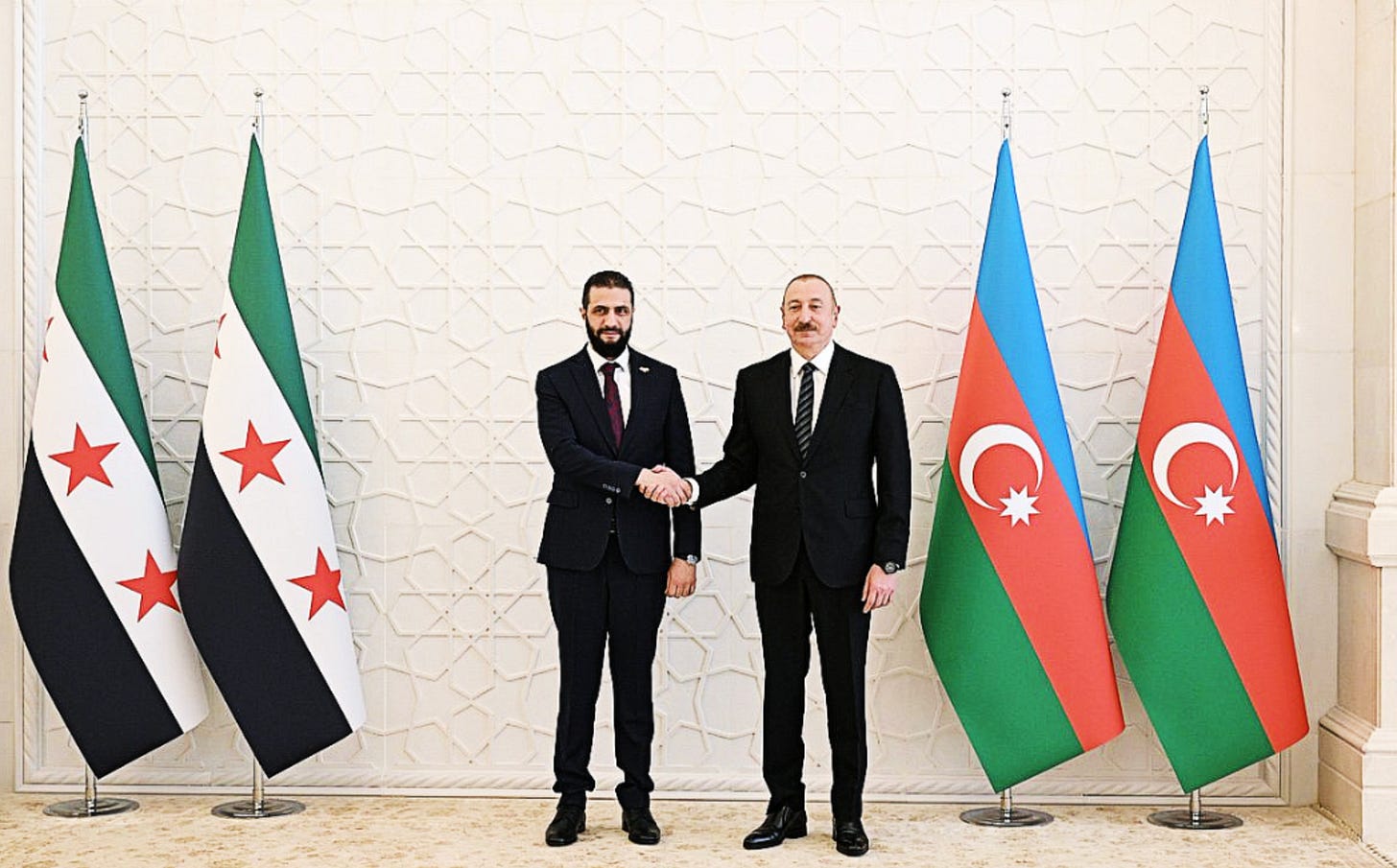
Al Qaeda chief, Jolani, meets President of Azerbaijan, Ilham Aliyev
It remains to be seen how realistic is a public normalisation deal between Syria and Israel. There are hardline factions within HTS that will reject it. This will exacerbate the divisions already forming under Jolani’s command which have been discussed in previous articles. Ordinary Syrians, who grew up with the history of conflict between Syria and Israel, would also reject such a step.
Israel is also divided between Netanyahu’s normalisation campaign and the more pragmatic factions in Israel that reject such a step with Syria, while the Al Qaeda regime and the President lack constitutional or electoral legitimacy. There is a clear threat that factions in Jolani’s militia might pose a security threat to Israel in the future. Trump is aligned with Netanyahu, despite the rumours of a rift between the two heads of state.
The aforementioned ‘security agreement’ would provide a satisfactory compromise, providing Jolani with a face-saving alternative to the humiliation of leading Syria into full normalisation with Israel, after decades of Syrian-led resistance to the Zionist entity and pro-Palestine solidarity. Israeli media has suggested that “such an agreement could lay the groundwork for an Abraham Accords-style normalisation after a period of trust-building”.
In return, Jolani must pledge to assist Israel with security against “Iran and its proxies in the region”. Since Jolani took power, he has been undermining the Palestinian resistance in Syria through imprisonment, expulsion, disarmament, and the closure of offices across the country. Syrian Palestinians are forbidden to protest in solidarity with Gaza. Such protests were being held weekly under the former government. More recently, Jolani’s administration is heading towards replacing the designation ‘Syrian Palestinian’ with ‘Palestinian resident’ in official documents for Palestinians in Syria.
This is a crucial reclassification of the legal identity of Palestinians in Syria that clearly has political motivations which comply with Israel’s security demands. Palestinians were previously given full Syrian citizenship rights, but without abandoning their Palestinian identity and their right to return to their land.
There have been indications for some time that Israel might try to force Gaza and West Bank Palestinians into Syria as part of the ethnic cleansing plan. Ongoing discussions between Syrians (not affiliated with Jolani) show that they fully understand that this will be the end of Palestine and while they would always give refuge to displaced Palestinians, they fear that this will lead to the Zionists’ ‘final solution’ and extermination of Palestinian presence in Palestine. Therefore, they oppose such a measure which would lead to serious backlash for Jolani should he agree to such a step.
On 13 July, Israeli media made the claim that Jolani met with Netanyahu’s special envoy in Baku, Azerbaijan. Central to the discussions between Jolani and Azerbaijan’s President Ilham Aliyev were solutions for Syria’s ongoing energy crisis, with the majority of oil reserves still occupied by the US and the Kurdish factions in the northeast. Azerbaijan proposed the export of natural gas to Syria via Turkey, which again brings Turkey into the picture, despite the challenges presented by competition with Israel.
However, it is certain, despite denials from various parties, that the main discussions were concerning the Syria-Israel security agreement. It is no coincidence that immediately after Jolani returned from Baku, tensions flared between Druze factions in southern Syria and the Bedouin, Syrian tribal factions linked to HTS and ISIS. This led to fierce and bloody clashes for 48 hours, which are still ongoing with HTS militia trying to gain control of the region and to bring the Druze factions to heel. Some factions within the Druze accepted a ceasefire, while others have continued fighting.
Israel will exploit the confrontation to fulfil the Zionist agenda to gain full access to and control over the Sweida province in southeast Syria, facilitating the David’s Corridor creation along the eastern border with Iraq and Jordan. To this end, a joint statement has been issued by PM Netanyahu and ‘Defence’ Minister Israel Katz pledging IOF military support for the Druze factions. This is a rapidly developing situation, one that I will cover in more detail in a future article.
HTS never had control of southern Syria. Formerly, it was Ahmed Al Awda and the pro-Russian forces of the Eighth Brigade that had maintained control, and were the first to enter Damascus on 8 December 2024. The UAE had attempted to mediate agreements between HTS and Al Awda, but with limited success.
Israel took control of much of the south and has expanded further with little resistance since the fall of Damascus. The security agreement with Israel actually relieves Jolani of the pressure to police the south, and eases the military burden for the Takfiri militia, making it easier to focus on Lebanon or any other target given to Jolani by the US and Israel.
According to Fars News, the choice of Baku as a venue for these meetings was a joint decision of Tel Aviv and Washington to send a threatening message to Iran. Azerbaijan stands accused by Iranian officials of allowing its airspace to be used by Israel to launch attacks against Iran during the 12-day war.
It is clear that Jolani is tied to a long-term project in the region that may take years to implement. Western allied intelligence agencies have learned from the experience in Afghanistan. Instead of deploying an Osama Bin Laden character, they have produced Jolani, suited and groomed by the British and Americans. Syrian territory is now a central Takfiri hub that can be deployed against all members of the Resistance Axis with relative ease. At least, this is the plan.
***
Please do consider subscribing. My work is dependent on public donations. Thank you to all who do. xxx

